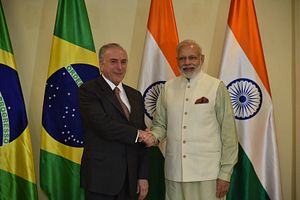Even as India prepares to join Brazil (along with Russia, China, and South Africa) for the next BRICS summit, India’s Latin American expedition seems obstructed.
To provide some context, India’s interaction with countries in Latin America and the Caribbean (LAC) is older than is generally acknowledged. The changes of the 1990s facilitated better interaction between the two in trade-related matters – both sides eventually came to hype the importance of their trade ties. Added to this, political ties also made the Indo-Latin America relationship significant. In that context, formation of BRICS and IBSA, irrespective of their impediments, was an appreciated effort. Such interactions (overlooking criticisms over China’s inclusion in BRICS) also a reflected of the kind of governments that existed in India and many of its LAC counterparts – democratic and favorably disposed to strengthening relations with the broader developing world. Ever since they were formed, critics have questioned the achievements and projected the subsequent demise of these ambitious initiatives. It is sufficient to note, however, that if the countries involved achieved less than expected under BRICS and IBSA, at least they were not harmed by being under such a grouping.
A decade later, a lot has changed — not only in India and LAC, but the world over. While the prospect of Brazilian exit from BRICS – Braxit –seems a good choice to some, such a proposition overlooks the real benefits Brazil gains from the grouping. In fact, most of those calling for an end to BRICS are not from the BRICS countries. These kind of propositions have long existed; however, with the Brazilian right coming to power, these anti-BRICS conspiracies have found a place in politics. At least for now, a Brazilian exit seems a near impossibility – however, the possibility that high-profile interactions in the broader South-South framework will altogether come to a halt is more than real.
At the political level, interactions between India and LAC countries have dropped to an all-time low. It seems evident there is an absence of real interest; the exchange of visits has become low-profile or all but disappeared.While India’s prime ministerial visits have gradually and substantially increased to other regions of the world, LAC countries are the exception. Prime Minister Narendra Modi, famous for his high number of foreign visits during his three years in office thus far, did not undertake an official visit to any country in LAC, aside from a working visit to Mexico in June 2016. His state visit to Fortaleza, Brazil can’t really be counted as it was primarily aimed at attending the 2014 BRICS Summit. No official visits to LAC are projected in 2017 either.
Modi’s non-attendance at the Non-Aligned Movement Summit at Venezuela last year in particular has been much discussed in the Indian media — especially as the decision came at a time when Venezuela needed India the most. India’s future interactions with LAC countries must downplay the differences and look into how much these far-off countries can interact. In the Modi government’s three years in power, there has been total neglect of the continent as a whole — which is a huge mistake on India’s part.
Even India’s trade with LAC countries has marginally fallen, and the list of top trading countries has been reshuffled. There has been decrease in trade volume, not only with the region as a whole but also with the individual countries. India’s trade relations even with regional economic groupings paints a gloomy picture.
If Modi’s statement at the St. Petersburg International Economic Forum is to be believed, however South-South interactions seem to be gaining ground again. There is no doubt that such statements were to be expected, largely due to the conditions created by Donald Trump’s rise to power in the United States.
Does that mean India will get close to Latin American countries? There is nothing to substantiate that point yet. Last year’s BRICS Summit in Goa was held in precarious situation, with the two right-wing governments in Brazil and India, both set to align themselves with the United States, meeting at a summit that more or less has been viewed as critical of American interests. Analysts doubted what would be achieved at the Goa Summit, largely owing to the domestic political scenarios in the member countries. The resulting joint statement did not contain any point strongly acknowledging that India and Brazil would become close to each other — and as we have seen, the BRICS gathering is essentially the only high-level communication India has had with Brazil or any LAC country in the past three years.
In such a situation, keep an eye on what will eventually comes out of this year’s BRICS Summit, to be held in Xiamen, China. While initiatives led by China are likely to get a lift, pay attention as well to the meeting between the Indian prime minister and Brazilian president for any indication that these two countries are ready to draw closer to each other.

































